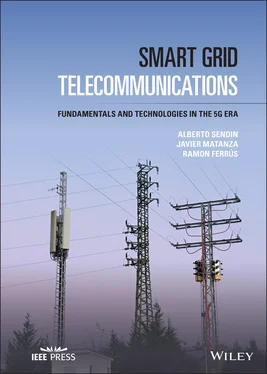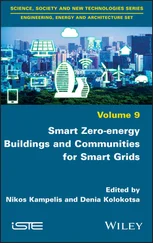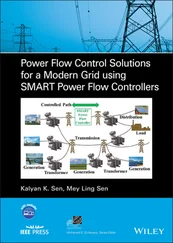Ramon Ferrús - Smart Grid Telecommunications
Здесь есть возможность читать онлайн «Ramon Ferrús - Smart Grid Telecommunications» — ознакомительный отрывок электронной книги совершенно бесплатно, а после прочтения отрывка купить полную версию. В некоторых случаях можно слушать аудио, скачать через торрент в формате fb2 и присутствует краткое содержание. Жанр: unrecognised, на английском языке. Описание произведения, (предисловие) а так же отзывы посетителей доступны на портале библиотеки ЛибКат.
- Название:Smart Grid Telecommunications
- Автор:
- Жанр:
- Год:неизвестен
- ISBN:нет данных
- Рейтинг книги:3 / 5. Голосов: 1
-
Избранное:Добавить в избранное
- Отзывы:
-
Ваша оценка:
- 60
- 1
- 2
- 3
- 4
- 5
Smart Grid Telecommunications: краткое содержание, описание и аннотация
Предлагаем к чтению аннотацию, описание, краткое содержание или предисловие (зависит от того, что написал сам автор книги «Smart Grid Telecommunications»). Если вы не нашли необходимую информацию о книге — напишите в комментариях, мы постараемся отыскать её.
Discover the foundations and main applications of telecommunications to smart grids Smart Grid Telecommunications,
Smart Grid Telecommunications
Smart Grid Telecommunications — читать онлайн ознакомительный отрывок
Ниже представлен текст книги, разбитый по страницам. Система сохранения места последней прочитанной страницы, позволяет с удобством читать онлайн бесплатно книгу «Smart Grid Telecommunications», без необходимости каждый раз заново искать на чём Вы остановились. Поставьте закладку, и сможете в любой момент перейти на страницу, на которой закончили чтение.
Интервал:
Закладка:
Transformer. The device that steps down the voltage from MV levels to LV.
LV panel. The element located beyond the transformer, connected to its secondary winding, and distributing the electric power in a number of LV feeders that will eventually reach Consumption Points. It is usually a large single panel or frame composed of four horizontal bars where the LV feeders are connected (for the three phases and the neutral). The LV switchboard usually is fitted with switches, overcurrent, and other protective elements. Figure 1.6 Different types of secondary substations.
LV feeders. These are the power lines supporting specific voltages and currents that deliver electric energy to customers. Usually several LV lines come out of a single SS, which then provide electric service to buildings and premises around.
SSs are more diverse in its nature, dimensions, and external appearance than PSs. The main reason lies in the need to adapt to the physical surroundings and specificities of the Consumption Points. SSs can thus be located indoor (in shelters, integrated in building spaces, or underground) or outdoor (with overhead transformers on poles or in compact surface cabinets – padmount transformers – or similar).
1.2.4.2 Power Lines
Cables, as the main component of power lines, are very important elements in terms of their numbers and wide‐spread installation. To have a reference of the dimension, organizations representing Transmission and Distribution system operators ENTSO‐E [13] and E.DSO [14] in Europe report almost 0.5 million km of HV cables and 8 million km of MV and LV cables.
Power lines connect substations, Generation and Consumption Points, and are also used inside substations and the consumer installations. The cables that are suspended on towers, or ducted underground, need to manage the voltages and currents (i.e., power, as voltage multiplied by current equals power), in an effective way. Thus, conductor material, type, size, and current rating characteristics are key factors in determining the choice of the proper cable for transmission lines, distribution lines, transformers, service wires, etc. [15].
Heating of conductors determines the current that can flow through. This heating depends on the resistance of the conductor (Joule effect), being the resistance per km a constant: the larger the diameter of the conductor or the better the conductivity of the metal used, the lower the resistance. Conductors are rated to support the current that causes them to heat up to a predetermined amount of degrees above ambient temperature, acceptable for the grid design of the utility. Current ratings depend on weather conditions and operational conditions to be determined by system designers.
Utilities use different conductor materials for different applications, being copper, aluminum, and steel the primary conductor materials used. Conductivity, durability, weight, strength, and cost are the factors that, combined, determine their use in the power system. Copper and aluminum are the best conductors (copper better than aluminum), but aluminum is lighter and more rust‐resistant than copper, while not as durable. Steel is the worst conductor, but its strength justifies its use in the core of aluminum conductors. The conductors can be found as a solid structure or stranded to create a more flexible structure than can also combine different metals to achieve the needed results. In general, solid conductors show better conductivity, while stranded conductors present improved mechanical flexibility and durability.
Power lines are more than individual cables, and cables are more than the conductors that carry electric power. Power lines can present different single cables running in parallel or can bundle them together if it is convenient for laying costs. Thus, conductors (single conductor or several conductor or cores) are fitted in cable structures that will manage to deliver the service needed, be it laid on overhead structures (towers or poles of different materials) or underground (ducted, preferably).
Underground networks are increasingly favored over overhead ones. Over recent years, Europe [16] has seen an increasing trend to replace existing overhead distribution lines with underground cabling, drivers being the higher reliability and safety of supply of underground solutions, their higher acceptance among citizens due to a reduced environmental impact, and the continuous decrease in the cost factor compared to overhead. In Europe, 41% of the MV grid and 55% of the LV grid are reported underground.
HV transmission grid lines consist of a combination of steel and aluminum conductors usually running overhead, except in some cases close to the urban areas. The towers supporting the weight of the conductors need to keep safety distances between them, with the metallic structure of the tower, and the ground [4]. To reduce the so‐called corona discharge (rupture of the insulation capacity of the air around the conductors due to high electrical fields), each phase of the line is generally divided into two, three, or more conductors. Inductance depends largely on the relative geometric position of the three phases on the tower. Capacitance among the conductors and with the earth also exists and determines their capacitance to ground. The inductive effect is dominant under heavy load situations (reactive energy consumption), while the capacitive effect is prevalent during light load periods (generation of reactive energy). HV underground systems are rare as their very short distance between the line and the ground requires the installation of heavy‐duty insulators. These lines have higher capacitive effect than overhead lines.
Overhead MV conductors can be classified in two major categories: homogeneous and non‐homogeneous. The first category includes copper, AAC, and AAAC, and the second category includes ACSR, ACAR, ACSS, or AACSR. Wires can be insulated or not insulated. The bare‐wired (un‐insulated) is the most common type of line used in overhead power lines. Covered wires (for improved reliability) are AAC, AAAC, or ACSR conductors covered with PE or XLPE (see Table 1.1).
Underground MV lines are considered safer and statistically more reliable than overhead ones. However, installation costs are significantly higher, although their maintenance cost is lower. Underground MV cables are basically a metallic conductor surrounded by an insulation system and a protective system. Its structure consists of the following elements: the inner conductor, the conductor shield, the insulation, the insulation shield, the neutral or shield, and the jacket. Underground cables can be single‐core or three‐core (thus three phases can be grouped together) and can have additional armored layers over the insulation to provide the cable with additional mechanical protection.
Table 1.1 Typical components of overhead medium voltage conductors.
| Acronym | Name |
|---|---|
| AAC | All‐aluminum conductor |
| AAAC | All‐aluminum alloy conductor |
| ACSR | Aluminum conductor steel reinforced |
| ACAR | Aluminum conductor alloy reinforced |
| ACSS | Aluminum conductor steel supported |
| AACSR | Aluminum alloy conductor steel reinforced |
| PE | Polyethylene |
| XLPE | Cross‐linked polyethylene |
| PVC | Polyvinyl chloride |
| EPR | Ethylene propylene rubber |
LV lines carry electricity from SSs to individual LV customers. In European countries, the LV grid is usually a larger infrastructure than the MV grid ([16] reports that LV is more than 63% of the distribution grid), while in North and Central American practice utilities' LV grids are practically nonexistent.
Читать дальшеИнтервал:
Закладка:
Похожие книги на «Smart Grid Telecommunications»
Представляем Вашему вниманию похожие книги на «Smart Grid Telecommunications» списком для выбора. Мы отобрали схожую по названию и смыслу литературу в надежде предоставить читателям больше вариантов отыскать новые, интересные, ещё непрочитанные произведения.
Обсуждение, отзывы о книге «Smart Grid Telecommunications» и просто собственные мнения читателей. Оставьте ваши комментарии, напишите, что Вы думаете о произведении, его смысле или главных героях. Укажите что конкретно понравилось, а что нет, и почему Вы так считаете.












